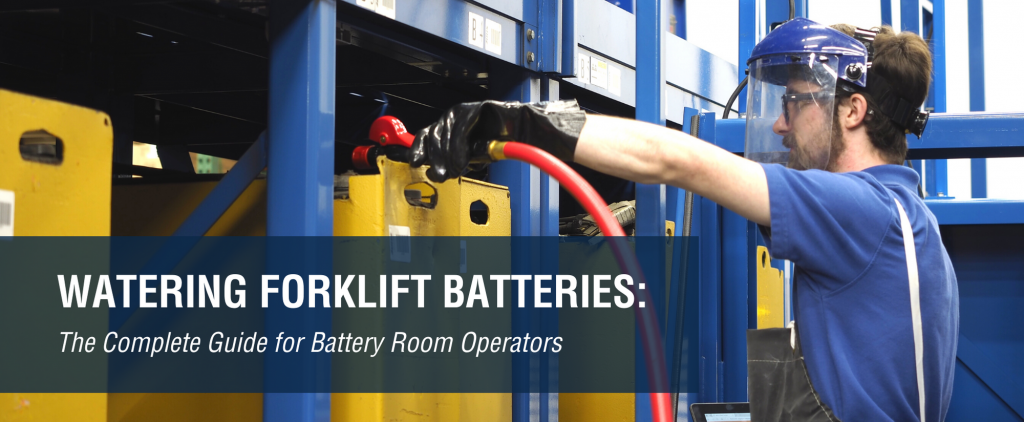Adding Water to Forklift Batteries: Best Practices and Safety Tips
Introduction
Forklift batteries are the backbone of material handling operations in warehouses, factories, and logistics centers. For the majority of forklifts still using lead-acid batteries, adding water is an essential maintenance task. Proper watering ensures battery longevity, consistent performance, and overall safety.
In this guide, we’ll cover why forklift batteries need water, when and how to add it, and safety precautions to prevent accidents. While maintenance-free lithium batteries are emerging as an alternative, this article primarily focuses on maintaining lead-acid forklift batteries.
Why Forklift Batteries Need Watering
Lead-acid batteries contain an electrolyte solution made of sulfuric acid and water. During normal battery operation, especially during charging, water is consumed through electrolysis, splitting into hydrogen and oxygen gases. Over time, water levels decrease, which can expose the lead plates and increase the risk of damage.
Failing to maintain proper water levels can result in:
- Reduced battery capacity: Exposed plates reduce efficiency.
- Shortened battery life: Sulfation occurs faster without proper water levels.
- Potential damage to forklift electronics: Low electrolyte can cause irregular voltage supply.
By regularly checking and adding water, operators can significantly extend the service life of their batteries and maintain reliable performance.
When to Add Water
Timing is crucial to safe and effective battery maintenance. Here are some guidelines:
- Check Frequency:
- Inspect batteries at least once a week.
- For high-use forklifts, inspect after every few charging cycles.
- Optimal Timing:
- Always add water after charging is complete, when the battery is at rest and cool.
- Adding water to a hot or charging battery can cause electrolyte overflow or rapid gas release.
- Temperature Considerations:
- Batteries operating in hot environments may require more frequent checks due to faster evaporation.
How to Add Water Safely
Adding water may seem simple, but improper technique can be dangerous. Follow these steps:
- Prepare Safety Gear
- Wear gloves and safety goggles to protect against sulfuric acid.
- Ensure good ventilation to prevent hydrogen gas accumulation.
- Check Electrolyte Levels
- Use the built-in markings (min/max) on each cell.
- Do not overfill; the water should just cover the plates and stay below the “max” line.
- Add Water Carefully
- Use distilled water only; tap water contains minerals that can reduce battery life.
- Add small amounts gradually, allowing the electrolyte to settle.
- Post-Maintenance Check
- Ensure caps are securely closed.
- Wipe off any spilled electrolyte with a damp cloth.
Key Tip: Never add water to a charging battery—this is a major safety risk.
Common Mistakes and Risks
Even experienced operators can make errors that compromise safety or battery life:
- Overfilling: Causes acid spillage, corrosion, and short-circuits.
- Underfilling: Exposes plates, accelerating sulfation and reducing lifespan.
- Using the wrong type of water: Tap water or mineral water can lead to sediment buildup and capacity loss.
- Poor ventilation: Hydrogen gas can accumulate and become explosive.
Proper training and adherence to safety procedures are essential to prevent accidents and maximize battery life.
Alternatives and Upgrades (Brief Note)
For operators looking for a low-maintenance alternative, lithium forklift batteries provide a maintenance-free solution without the need for adding water. They offer faster charging, longer lifespan, and higher energy efficiency.
Learn more about available options here: Forklift Lithium Battery Solutions.
For operators considering upgrades for specific brands like Jungheinrich, this detailed guide is highly recommended: Jungheinrich Forklift Battery Replacement Guide.
Conclusion
Regularly adding water to lead-acid forklift batteries is a critical step in maintaining performance and extending battery life. By following proper timing, using distilled water, and adhering to safety precautions, operators can avoid common mistakes and reduce downtime.
While lithium forklift batteries present an attractive maintenance-free option, the majority of operators today still rely on correct watering practices to ensure reliable forklift performance. Keeping this simple maintenance habit will save costs and improve operational efficiency in the long run.


